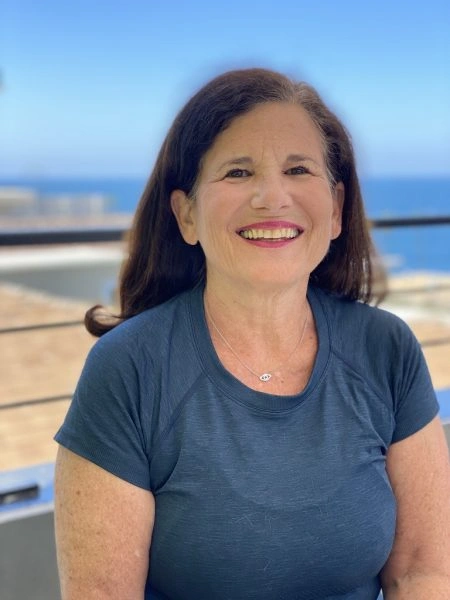Yoma 64
רָבָא אָמַר: כְּגוֹן שֶׁהָיָה לוֹ חוֹלֶה בְּתוֹךְ בֵּיתוֹ, וְשָׁחַט אִמּוֹ בְּיוֹם הַכִּפּוּרִים.
The Gemara presents another explanation as to why a verse is needed to indicate that the scapegoat may not be lacking time. Rava said: It is referring to a case where the one who sold the two goats had a critically ill person in his household, and he slaughtered the mother of the scapegoat in order to save the ill person’s life on Yom Kippur. Although the scapegoat is more than eight days old, it is considered lacking time because it is prohibited to slaughter a mother animal and its offspring on the same day.
וְכִי הַאי גַּוְונָא מִי אֲסִיר? ״לֹא תִשְׁחֲטוּ״ אָמַר רַחֲמָנָא, וְהָא לָאו שְׁחִיטָה הִיא! הָא אָמְרִי בְּמַעְרְבָא דְּחִיָּיתוֹ לַצּוּק זוֹ הִיא שְׁחִיטָתוֹ.
The Gemara asks: Is it prohibited in a case like this? The Merciful One stated in the Torah: “And whether it be a cow or ewe, you shall not slaughter it and its young on one day” (Leviticus 22:28), and this act of pushing the scapegoat off the cliff is not a ritual slaughter. Consequently, the prohibition against slaughtering a mother animal and its offspring should not apply. The Gemara answers: They say in the West, i.e., Eretz Yisrael, that pushing it off the cliff, which is the manner in which the scapegoat is supposed to be killed, is considered its slaughter.
אִם שֶׁל שֵׁם מֵת, זֶה שֶׁעָלָה עָלָיו וְכוּ׳.
§ It was taught in the mishna that if one of the goats dies after the lottery, a second pair of goats is sought and new lots are drawn. After that lottery, the priest utters a stipulation: If the one to be sacrificed to God died, that goat upon which the lot for God was drawn shall stand in its stead; and if the one to be sent to Azazel died, that goat upon which the lot for Azazel was drawn shall stand in its stead. The second, superfluous goat should graze until it becomes blemished, at which point it will be sold and the money received in its sale will go to the purchase of a public gift-offering. The Gemara discusses which goat is set to pasture: The one that remains from the first lottery or the one that remains from the second lottery?
אָמַר רַב: שֵׁנִי שֶׁבְּזוּג רִאשׁוֹן — יִקְרַב, שֵׁנִי שֶׁבְּזוּג שֵׁנִי — יִרְעֶה. רַבִּי יוֹחָנָן אָמַר: שֵׁנִי שֶׁבְּזוּג רִאשׁוֹן — יִרְעֶה, שֵׁנִי שֶׁבַּזּוּג שֵׁנִי — יִקְרַב.
Rav said: If the goat to be sent to Azazel died, he should sacrifice the second goat of the first pair to God, and the second goat of the second pair should graze until it becomes unfit. Rabbi Yoḥanan said: The second goat of the first pair is the one that should graze, whereas he should sacrifice the second goat of the second pair.
בְּמַאי קָא מִיפַּלְגִי? רַב סָבַר: בַּעֲלֵי חַיִּים אֵינָן נִידְחִין, וְרַבִּי יוֹחָנָן סָבַר: בַּעֲלֵי חַיִּים נִידְחִין.
The Gemara asks: With regard to what principle do they disagree? The Gemara explains: Rav holds that animals are not rejected. An animal that was consecrated as an offering but later became unfit for sacrifice is not considered disqualified forever. Therefore, although the remaining goat was not eligible to be sacrificed when its counterpart died, once another goat has been paired with it following a new lottery, it is no longer rejected and should be sacrificed. And Rabbi Yoḥanan holds that animals are rejected. Therefore, once the remaining goat from the first pair became disqualified, it remains disqualified forever.
מַאי טַעְמָא דְּרַב? דְּיָלֵיף מִמְּחוּסַּר זְמַן. מְחוּסַּר זְמַן, לָאו אַף עַל גַּב דְּהַשְׁתָּא לָא חֲזֵי, כִּי הָדַר מִיחֲזֵי — שַׁפִּיר דָּמֵי, הָכָא נָמֵי לָא שְׁנָא. מִי דָּמֵי? הָתָם לָא אִיתְחֲזִי כְּלָל. הָכָא נִרְאָה וְנִדְחָה!
The Gemara asks: What is the reason for the opinion of Rav? The Gemara answers: He derives it from the halakha applicable to an animal that is lacking time. In the case of an animal that is lacking time, is it not true that although it is unfit now, when it again becomes fit, it seems well, i.e., it may be sacrificed as an offering? Here, too, it is no different. The Gemara rejects this answer: Is it comparable? There, when the animal is lacking time, it was never fit to be sacrificed. Here, the animal was fit as an offering and later became unfit and was therefore rejected. Perhaps in this case it is permanently disqualified.
אֶלָּא: הַיְינוּ טַעְמָא דְּרַב, דְּיָלֵיף מִבַּעַל מוּם עוֹבֵר. בַּעַל מוּם עוֹבֵר, לָאו אַף עַל גַּב דְּלָא חֲזֵי הַשְׁתָּא, כִּי הָדַר מִיחֲזֵי — שַׁפִּיר דָּמֵי, הָכָא נָמֵי לָא שְׁנָא.
Rather, the Gemara retracts the first explanation and says that this is the reasoning of Rav: He derives it from the case of an animal with a temporary blemish. The animal is disqualified as an offering as long as the blemish remains, but is eligible for sacrifice once the blemish has healed. In the case of an animal with a temporary blemish, is it not true that although it is unfit now, when it again becomes fit, it seems well, i.e., it may be sacrificed as an offering? Here too, it is no different.
וְהָתָם מְנָא לַן? דִּכְתִיב: ״כִּי מׇשְׁחָתָם בָּהֶם מוּם בָּם״, מוּם בָּם — הוּא דְּלֹא יֵרָצוּ, הָא עָבַר מוּמָן — יֵרָצוּ.
The Gemara asks: There, in the case of an animal with a temporary blemish, from where do we derive this halakha? As it is written: “Because their corruption is in them, there is a blemish in them; they shall not be accepted for you” (Leviticus 22:25), which teaches us: It is when the blemish is in them that they shall not be accepted; but if their blemish passes, they shall be accepted.
וְרַבִּי יוֹחָנָן? מִיעֵט רַחֲמָנָא ״בָּהֶם״, הֵם הוּא דְּכִי עָבַר מוּמָן יֵרָצוּ, הָא כׇּל דְּחוּיִין, הוֹאִיל וְנִדְחוּ — נִדְחוּ.
The Gemara asks: And what does Rabbi Yoḥanan respond to this proof? The Merciful One limited this halakha by using the term: In them, which indicates that it is they, animals with temporary blemishes, that are accepted when their blemishes pass, but with regard to all other animals that become disqualified, once they are rejected they remain rejected.
וְרַב? הָהוּא ״בָּהֶם״ בְּעֵינַיְיהוּ הוּא דְּלָא מִירְצוּ, הָא עַל יְדֵי תַּעֲרוֹבוֹת — מִירְצוּ.
The Gemara asks: And how does Rav answer Rabbi Yoḥanan? That term: In them, should be understood as follows: It is on their own that they are not accepted; but in mixtures with animals that are fit to be sacrificed, animals that have a temporary blemish are accepted.
כְּדִתְנַן: אֵיבָרִים תְּמִימִים בְּאֵיבָרִים בַּעֲלֵי מוּמִין. רַבִּי אֱלִיעֶזֶר אוֹמֵר: אִם קָרַב הָרֹאשׁ שֶׁל אֶחָד מֵהֶן — יַקְרִיבוּ כׇּל הָרָאשִׁין כּוּלָּן, כְּרָעָיו שֶׁל אֶחָד מֵהֶן — יַקְרִיבוּ כָּל הַכְּרָעַיִים כּוּלָּן. וַחֲכָמִים אוֹמְרִים: אֲפִילּוּ קָרְבוּ כּוּלָּן חוּץ מֵאֶחָד מֵהֶן — יֵצֵא לְבֵית הַשְּׂרֵיפָה.
As we learned in a mishna: If limbs from unblemished burnt-offerings became mixed with limbs from blemished burnt-offerings, which are disqualified, Rabbi Eliezer says: If the head of one of them is sacrificed on the altar before they knew of the blemish, they should sacrifice all the heads, as it is assumed that the head of the disqualified animal was the one already sacrificed on the altar. Similarly, if the legs of one of them were sacrificed, they should sacrifice all the legs. And the Rabbis say: Even if all of them were sacrificed except for one, that one should be taken out to the place designated for burning disqualified offerings, as it is not assumed that the limbs of the disqualified animal have already been brought.
וְאִידַּךְ? נָפְקָא לֵיהּ מִ״בָּם״ ״בָּהֶם״. וְאִידַּךְ? ״בָּם״ ״בָּהֶם״ לָא דָּרֵישׁ.
The Gemara asks: And how does the other Sage, Rabbi Yoḥanan, derive the halakha that the limbs are acceptable if they are in a mixture? The Gemara answers: He derives it from the Torah’s choice of terminology: It could have written: “In them,” as bam, but instead it used the term bahem, with the extra letter heh, and therefore an extra halakha can be derived from this word. The Gemara comments: And the other Sage, Rav, does not expound the difference in terminology between the words bam and bahem, as he does not consider the distinction significant enough to teach a halakha.
וּלְרַב, נְהִי נָמֵי דְּבַעֲלֵי חַיִּים אֵינָן נִדְחִין, אִי בָּעֵי הַאי נַקְרֵיב אִי בָּעֵי הַאי נַקְרֵיב!
The Gemara asks: According to Rav, although living beings are not permanently rejected, that only explains why the remaining goat of the first pair is acceptable for sacrifice, but why must it be the one to be sacrificed? If he wants this one from the first pair he should sacrifice it, and if he wants that one from the second pair, he should sacrifice that.
אָמַר רָבָא: רַב סָבַר לַהּ כְּרַבִּי יוֹסֵי, דְּאָמַר: מִצְוָה בָּרִאשׁוֹן. הֵי רַבִּי יוֹסֵי? אִי נֵימָא רַבִּי יוֹסֵי דְּקוּפּוֹת, דִּתְנַן: שָׁלֹשׁ קוּפּוֹת שֶׁל שָׁלֹשׁ שָׁלֹשׁ סְאִין, שֶׁבָּהֶן תּוֹרְמִין אֶת הַלִּשְׁכָּה, וְכָתוּב עֲלֵיהֶן: אָלֶף בֵּית גִּימֶל. וְתַנְיָא, אָמַר רַבִּי יוֹסֵי: לָמָּה כָּתוּב עֲלֵיהֶן אָלֶף בֵּית גִּימֶל — לֵידַע אֵיזֶה מֵהֶן נִתְרְמָה רִאשׁוֹן, לְהָבִיא הֵימֶנָּה רִאשׁוֹן, שֶׁמִּצְוָה בָּרִאשׁוֹן.
Rava said: Rav holds in accordance with the opinion of Rabbi Yosei, who said: The mitzva should be fulfilled with the goat from the first pair. The Gemara asks: Which statement of Rabbi Yosei indicates that this is his opinion? If we say it is the statement of Rabbi Yosei with regard to the containers, as we learned in a mishna: There were three containers, each of which held three se’a, with which they collected coins from the chamber. And the letters alef, beit, and gimmel were written on them. And it was taught in a baraita that Rabbi Yosei said: Why were alef, beit, and gimmel written on them? In order to know which of them was collected from the chamber first, in order to bring an offering from it first, as the mitzva is performed with the first one.
דִּילְמָא שָׁאנֵי הָתָם, דִּבְעִידָּנָא דְּאִתְחֲזַי קַמַּיְיתָא לָא אִתְחֲזַי בָּתְרָיְיתָא.
That statement of Rabbi Yosei cannot serve as the source for Rav’s opinion. Perhaps it is different there, in the case of the containers, because at the time when the first container of coins was fit for use, the containers used later were not yet fit for use. Therefore, it cannot serve as a precedent with regard to a case in which both became fit for use at the same time. In the case of the Yom Kippur goats, none of the goats are actually fit for sacrifice until the point in the Temple service when they are supposed to be sacrificed. By that time, lots have already been drawn for the second pair of goats.
אֶלָּא רַבִּי יוֹסֵי דְּפֶסַח, (דִּתְנַן:) הַמַּפְרִישׁ פִּסְחוֹ וְאָבַד, וְהִפְרִישׁ אַחֵר תַּחְתָּיו, וְאַחַר כָּךְ נִמְצָא הָרִאשׁוֹן, וַהֲרֵי שְׁנֵיהֶן עוֹמְדִין — אֵיזֶה מֵהֶן שֶׁיִּרְצֶה יִקְרַב, דִּבְרֵי חֲכָמִים. רַבִּי יוֹסֵי אוֹמֵר: מִצְוָה בָּרִאשׁוֹן.
Rather, the source of Rav’s opinion is the statement of Rabbi Yosei with regard to the Paschal lamb. As we learned in a baraita: With regard to one who separated an animal as his Paschal lamb and it became lost, and he separated another in its stead, and afterward, but before midday on the eve of Passover, the first one is found, and they are both standing before him, the owner may bring whichever of them he wishes. This is the statement of the Rabbis. Rabbi Yosei says: The mitzva should be performed with the first one.
וְאִם הָיָה הַשֵּׁנִי מוּבְחָר מִמֶּנּוּ — יְבִיאֶנּוּ.
And if the second one was superior to it, he brings that one. This demonstrates that according to Rabbi Yosei, when the two animals become fit for sacrifice at the same time, preference should be given to the first one unless the second one is superior.
אָמַר רָבָא: דַּיְקָא מַתְנִיתִין כְּווֹתֵיהּ דְּרַב, וּבָרַיְיתָא כְּווֹתֵיהּ דְּרַבִּי יוֹחָנָן. מַתְנִיתִין כְּווֹתֵיהּ דְּרַב, דְּקָתָנֵי: אִם שֶׁל שֵׁם מֵת — זֶה שֶׁעָלָה עָלָיו הַגּוֹרָל לַשֵּׁם יִתְקַיֵּים תַּחְתָּיו, וְאִידַּךְ כִּדְקָאֵי קָאֵי.
Rava said: The language of the mishna is precise in accordance with the opinion of Rav, and the language of the baraita is precise in accordance with the opinion of Rabbi Yoḥanan. The Gemara explains: The language of the mishna is precise in accordance with the opinion of Rav, as it teaches: If the one to be sacrificed to God died, that goat upon which the lot for God was drawn shall stand in its stead. And the other goat stands as it stood before, i.e., its status does not change, in accordance with the opinion of Rav.
בָּרַיְיתָא כְּווֹתֵיהּ דְּרַבִּי יוֹחָנָן, דְּקָתָנֵי: ״שֵׁנִי״, אֵינִי יוֹדֵעַ אִם שֵׁנִי שֶׁבְּזוּג רִאשׁוֹן אִם שֵׁנִי שֶׁבְּזוּג שֵׁנִי, כְּשֶׁהוּא אוֹמֵר ״יׇעֳמַד חַי״, וְלֹא שֶׁחֲבֵירוֹ מֵת. מַאי מַשְׁמַע? ״יׇעֳמַד חַי״, וְלֹא שֶׁכְּבָר עָמַד.
The language of the baraita is precise in accordance with the opinion of Rabbi Yoḥanan, as it teaches: When the mishna says that the second goat is left to graze, I do not know whether it is referring to the second goat of the first pair, or the second goat of the second pair. When the verse states: “It shall be stood alive before the Lord, to make atonement over him, to send him away to Azazel into the wilderness” (Leviticus 16:10), it is not referring to the goat whose counterpart died. The Gemara asks: From where may it be inferred, i.e., how does the verse indicate this point? The Gemara answers that it states: “It shall be stood alive,” in the future tense, indicating that it is not referring to the one that already stood with its counterpart that died.
תְּנַן, וְעוֹד אָמַר רַבִּי יְהוּדָה: נִשְׁפַּךְ הַדָּם — יָמוּת הַמִּשְׁתַּלֵּחַ, מֵת הַמִּשְׁתַּלֵּחַ — יִשָּׁפֵךְ הַדָּם. בִּשְׁלָמָא לְרַבִּי יוֹחָנָן, דְּאָמַר בַּעֲלֵי חַיִּים נִדְחִין — מִשּׁוּם הָכִי יָמוּת הַמִּשְׁתַּלֵּחַ. אֶלָּא לְרַב, דְּאָמַר בַּעֲלֵי חַיִּים אֵינָן נִדְחִין — אַמַּאי יָמוּת הַמִּשְׁתַּלֵּחַ?
We learned in the mishna: And furthermore, Rabbi Yehuda said: If the blood of the goat sacrificed to God spilled before it was sprinkled, the scapegoat is left to die. Similarly, if the scapegoat dies, the blood of the goat sacrificed to God should be spilled, and two other goats are brought and lots are drawn. Granted, according to Rabbi Yoḥanan, who said that animals that become disqualified are permanently rejected, even after the source of their initial disqualification is no longer present, due to that reason the scapegoat is left to die. However, according to Rav, who said that animals are not permanently rejected, why is the scapegoat left to die?
אָמַר לְךָ רַב: אַלִּיבָּא דְּרַבִּי יְהוּדָה לָא קָא אָמֵינָא. כִּי אָמֵינָא, אַלִּיבָּא דְּרַבָּנַן.
Rav could have said to you: I did not state my opinion in accordance with the opinion of Rabbi Yehuda. I stated my opinion in accordance with the opinion of the Rabbis. Rabbi Yehuda holds that disqualified animals are permanently rejected and communal sin-offerings may be left to die. The Rabbis disagree with both issues and hold that disqualified animals are not permanently disqualified, and communal sin-offerings that are disqualified are not left to die, but rather graze until they develop a blemish, and then are sold. Rav, who holds that the remaining goat from the first pair is sacrificed, states his opinion in accordance with the opinion of the Rabbis, i.e., that disqualified animals are not permanently rejected.
בִּשְׁלָמָא לְרַב, בְּהָא פְּלִיגִי רַבִּי יְהוּדָה וְרַבָּנַן. אֶלָּא לְרַבִּי יוֹחָנָן, בְּמַאי פְּלִיגִי? אָמַר רָבָא: הָא אָמְרִינַן דַּיְיקָא מַתְנִיתִין כְּווֹתֵיהּ דְּרַב.
The Gemara comments: Granted, according to the opinion of Rav, Rabbi Yehuda and the Rabbis disagree with regard to whether disqualified animals are permanently rejected. However, according to the opinion of Rabbi Yoḥanan, who holds that even according to the Rabbis the remaining goat of the first pair is left to graze, with regard to what principle do Rabbi Yehuda and the Rabbis disagree? Rava said: Didn’t we say that the language of the mishna is precise in accordance with the opinion of Rav, and it is difficult to explain the mishna’s language in accordance with the opinion of Rabbi Yoḥanan?
תְּנַן: שֶׁאֵין חַטַּאת צִבּוּר מֵתָה. הָא דְּיָחִיד כִּי הַאי גַוְונָא — מֵתָה. בִּשְׁלָמָא לְרַבִּי יוֹחָנָן, כִּדְרַבִּי אַבָּא אָמַר רַב. דְּאָמַר רַבִּי אַבָּא אָמַר רַב:
We learned in the mishna that a communal sin-offering is not left to die. This indicates that the sin-offering of an individual in a case like this is left to die. Granted, according to the opinion of Rabbi Yoḥanan, who holds that the remaining goat from the first pair is left to graze until it develops a blemish, it can be explained that the sin-offering of an individual in a comparable case is killed, in accordance with the opinion that Rabbi Abba said that Rav said. As Rabbi Abba said that Rav said:

























